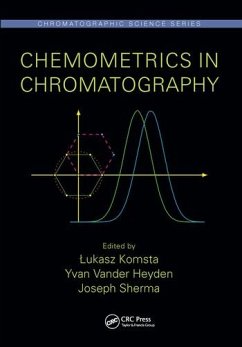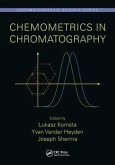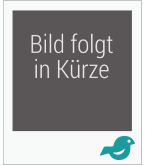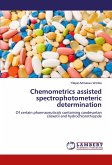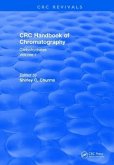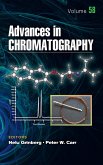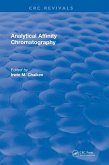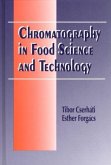Chemometrics in Chromatography
Herausgeber: Komsta, ¿Ukasz; Sherma, Joseph; Heyden, Yvan Vander
Chemometrics in Chromatography
Herausgeber: Komsta, ¿Ukasz; Sherma, Joseph; Heyden, Yvan Vander
- Broschiertes Buch
- Merkliste
- Auf die Merkliste
- Bewerten Bewerten
- Teilen
- Produkt teilen
- Produkterinnerung
- Produkterinnerung
An up-to-date reference that presents the most important information about each area of chemometrics used in chromatography, demonstrating its effective use when applied to a chromatographic separation.
Andere Kunden interessierten sich auch für
![Chemometrics in Chromatography Chemometrics in Chromatography]() Chemometrics in Chromatography292,99 €
Chemometrics in Chromatography292,99 €![BASIC CHEMOMETRICS FOR ANALYTICAL CHEMISTS BASIC CHEMOMETRICS FOR ANALYTICAL CHEMISTS]() Andrade-Garda JoseBASIC CHEMOMETRICS FOR ANALYTICAL CHEMISTS103,99 €
Andrade-Garda JoseBASIC CHEMOMETRICS FOR ANALYTICAL CHEMISTS103,99 €![Chemometrics assisted spectrophotometeric determination Chemometrics assisted spectrophotometeric determination]() Yitayal Admassu WorkieChemometrics assisted spectrophotometeric determination26,99 €
Yitayal Admassu WorkieChemometrics assisted spectrophotometeric determination26,99 €![Handbook of Chromatography Vol I (1982) Handbook of Chromatography Vol I (1982)]() Handbook of Chromatography Vol I (1982)65,99 €
Handbook of Chromatography Vol I (1982)65,99 €![Advances in Chromatography Advances in Chromatography]() Advances in Chromatography163,99 €
Advances in Chromatography163,99 €![Analytical Affinity Chromatography Analytical Affinity Chromatography]() Irwin M. ChaikenAnalytical Affinity Chromatography159,99 €
Irwin M. ChaikenAnalytical Affinity Chromatography159,99 €![Chromatography in Food Science and Technology Chromatography in Food Science and Technology]() Tibor CserhatiChromatography in Food Science and Technology483,99 €
Tibor CserhatiChromatography in Food Science and Technology483,99 €-
-
-
An up-to-date reference that presents the most important information about each area of chemometrics used in chromatography, demonstrating its effective use when applied to a chromatographic separation.
Produktdetails
- Produktdetails
- Verlag: CRC Press
- Seitenzahl: 526
- Erscheinungstermin: 30. Juni 2020
- Englisch
- Abmessung: 246mm x 189mm x 28mm
- Gewicht: 1006g
- ISBN-13: 9780367572235
- ISBN-10: 0367572230
- Artikelnr.: 69890695
- Herstellerkennzeichnung
- Libri GmbH
- Europaallee 1
- 36244 Bad Hersfeld
- gpsr@libri.de
- Verlag: CRC Press
- Seitenzahl: 526
- Erscheinungstermin: 30. Juni 2020
- Englisch
- Abmessung: 246mm x 189mm x 28mm
- Gewicht: 1006g
- ISBN-13: 9780367572235
- ISBN-10: 0367572230
- Artikelnr.: 69890695
- Herstellerkennzeichnung
- Libri GmbH
- Europaallee 1
- 36244 Bad Hersfeld
- gpsr@libri.de
?ukasz Komsta, Yvan Vander Heyden, Joseph Sherma
TABLE OF CONTENTS Preface 1. Method development and optimization 1. Experimental design in chromatographic method development and validation (
ukasz Komsta, Yvan Vander Heyden) 2. Chromatographic response functions (Regina M. B. O. Duarte, João T. V. Matos, Armando C. Duarte) 3. Chemometric strategies to characterize stationary phases (Charlene Galea, Debby Mangelings, Yvan Vander Heyden) 4. Chromatographic applications of genetic algorithms and other nature-inspired optimization methods (Mohammad Goodarzi, Yvan Vander Heyden) 1. Univariate analysis 1. Statistics and validation in quantitative chromatographic analysis (Eliangiringa Kaale, Danstan Shewiyo, David Jenkins) 2. Statistical evaluation of calibration curves in chromatography (Sven Declerck, Johan Viaene, Ines Salsinha, Yvan Vander Heyden) 1. Data preprocessing and unsupervised analysis 1. Introduction to multivariate data treatment (
ukasz Komsta, Yvan Vander Heyden) 2. Introduction to exploratory and clustering techniques (Ivana Stanimirova, Michä Daszykowski) 3. Denoising of signals, signal enhancement and baseline correction in chromatographic science (Zhi-Min Zhang, Hong-Mei Lu, Yi-Zeng Liang) 4. Alignment of one- and two-dimensional chromatographic signals (Michä Daszykowski) 5. Peak purity and resolution of chromatographic data (Silvia Mas, Anna de Juan) 6. Modeling of peak shape and asymmetry (Jose Ramon Torres, Juan Jose Baeza-Baeza, Maria Celia Garcia-Alvarez-Coque,) 7. Missing and censored data in chromatography (Ivana Stanimirova) 1. Classification, discrimination and calibration 1. Linear supervised techniques (
ukasz Komsta, Yvan Vander Heyden) 2. Discriminant analysis, and classification of chromatographic data (Alessandra Biancolillo, Federico Marini) 3. Nonlinear supervised techniques (Geert Postma, Lionel Blanchet, Frederik-Jan van Schooten, Lutgarde Buydens) 1. Retention modelling 1. Introduction to quantitative structure-retention relationships (QSRRs) (Krzesimir Ciura, Piotr Kawczak, Joanna Nowakowska, Tomasz B
czek) 2. Topological Indices in modelling chromatographic retention (Mägorzata Do
owy, Katarzyna Bober, Alina Pyka-Paj
k) 1. Application overviews 1. Introduction to fingerprinting in chromatography (Johan Viaene and Yvan Vander Heyden) 2. Chemometric strategies in analysis of chromatographic-mass spectrometry data (Samantha Riccadonna, Pietro Franceschi) 3. Chemometric strategies
ukasz Komsta, Yvan Vander Heyden) 2. Chromatographic response functions (Regina M. B. O. Duarte, João T. V. Matos, Armando C. Duarte) 3. Chemometric strategies to characterize stationary phases (Charlene Galea, Debby Mangelings, Yvan Vander Heyden) 4. Chromatographic applications of genetic algorithms and other nature-inspired optimization methods (Mohammad Goodarzi, Yvan Vander Heyden) 1. Univariate analysis 1. Statistics and validation in quantitative chromatographic analysis (Eliangiringa Kaale, Danstan Shewiyo, David Jenkins) 2. Statistical evaluation of calibration curves in chromatography (Sven Declerck, Johan Viaene, Ines Salsinha, Yvan Vander Heyden) 1. Data preprocessing and unsupervised analysis 1. Introduction to multivariate data treatment (
ukasz Komsta, Yvan Vander Heyden) 2. Introduction to exploratory and clustering techniques (Ivana Stanimirova, Michä Daszykowski) 3. Denoising of signals, signal enhancement and baseline correction in chromatographic science (Zhi-Min Zhang, Hong-Mei Lu, Yi-Zeng Liang) 4. Alignment of one- and two-dimensional chromatographic signals (Michä Daszykowski) 5. Peak purity and resolution of chromatographic data (Silvia Mas, Anna de Juan) 6. Modeling of peak shape and asymmetry (Jose Ramon Torres, Juan Jose Baeza-Baeza, Maria Celia Garcia-Alvarez-Coque,) 7. Missing and censored data in chromatography (Ivana Stanimirova) 1. Classification, discrimination and calibration 1. Linear supervised techniques (
ukasz Komsta, Yvan Vander Heyden) 2. Discriminant analysis, and classification of chromatographic data (Alessandra Biancolillo, Federico Marini) 3. Nonlinear supervised techniques (Geert Postma, Lionel Blanchet, Frederik-Jan van Schooten, Lutgarde Buydens) 1. Retention modelling 1. Introduction to quantitative structure-retention relationships (QSRRs) (Krzesimir Ciura, Piotr Kawczak, Joanna Nowakowska, Tomasz B
czek) 2. Topological Indices in modelling chromatographic retention (Mägorzata Do
owy, Katarzyna Bober, Alina Pyka-Paj
k) 1. Application overviews 1. Introduction to fingerprinting in chromatography (Johan Viaene and Yvan Vander Heyden) 2. Chemometric strategies in analysis of chromatographic-mass spectrometry data (Samantha Riccadonna, Pietro Franceschi) 3. Chemometric strategies
TABLE OF CONTENTS Preface 1. Method development and optimization 1. Experimental design in chromatographic method development and validation (
ukasz Komsta, Yvan Vander Heyden) 2. Chromatographic response functions (Regina M. B. O. Duarte, João T. V. Matos, Armando C. Duarte) 3. Chemometric strategies to characterize stationary phases (Charlene Galea, Debby Mangelings, Yvan Vander Heyden) 4. Chromatographic applications of genetic algorithms and other nature-inspired optimization methods (Mohammad Goodarzi, Yvan Vander Heyden) 1. Univariate analysis 1. Statistics and validation in quantitative chromatographic analysis (Eliangiringa Kaale, Danstan Shewiyo, David Jenkins) 2. Statistical evaluation of calibration curves in chromatography (Sven Declerck, Johan Viaene, Ines Salsinha, Yvan Vander Heyden) 1. Data preprocessing and unsupervised analysis 1. Introduction to multivariate data treatment (
ukasz Komsta, Yvan Vander Heyden) 2. Introduction to exploratory and clustering techniques (Ivana Stanimirova, Michä Daszykowski) 3. Denoising of signals, signal enhancement and baseline correction in chromatographic science (Zhi-Min Zhang, Hong-Mei Lu, Yi-Zeng Liang) 4. Alignment of one- and two-dimensional chromatographic signals (Michä Daszykowski) 5. Peak purity and resolution of chromatographic data (Silvia Mas, Anna de Juan) 6. Modeling of peak shape and asymmetry (Jose Ramon Torres, Juan Jose Baeza-Baeza, Maria Celia Garcia-Alvarez-Coque,) 7. Missing and censored data in chromatography (Ivana Stanimirova) 1. Classification, discrimination and calibration 1. Linear supervised techniques (
ukasz Komsta, Yvan Vander Heyden) 2. Discriminant analysis, and classification of chromatographic data (Alessandra Biancolillo, Federico Marini) 3. Nonlinear supervised techniques (Geert Postma, Lionel Blanchet, Frederik-Jan van Schooten, Lutgarde Buydens) 1. Retention modelling 1. Introduction to quantitative structure-retention relationships (QSRRs) (Krzesimir Ciura, Piotr Kawczak, Joanna Nowakowska, Tomasz B
czek) 2. Topological Indices in modelling chromatographic retention (Mägorzata Do
owy, Katarzyna Bober, Alina Pyka-Paj
k) 1. Application overviews 1. Introduction to fingerprinting in chromatography (Johan Viaene and Yvan Vander Heyden) 2. Chemometric strategies in analysis of chromatographic-mass spectrometry data (Samantha Riccadonna, Pietro Franceschi) 3. Chemometric strategies
ukasz Komsta, Yvan Vander Heyden) 2. Chromatographic response functions (Regina M. B. O. Duarte, João T. V. Matos, Armando C. Duarte) 3. Chemometric strategies to characterize stationary phases (Charlene Galea, Debby Mangelings, Yvan Vander Heyden) 4. Chromatographic applications of genetic algorithms and other nature-inspired optimization methods (Mohammad Goodarzi, Yvan Vander Heyden) 1. Univariate analysis 1. Statistics and validation in quantitative chromatographic analysis (Eliangiringa Kaale, Danstan Shewiyo, David Jenkins) 2. Statistical evaluation of calibration curves in chromatography (Sven Declerck, Johan Viaene, Ines Salsinha, Yvan Vander Heyden) 1. Data preprocessing and unsupervised analysis 1. Introduction to multivariate data treatment (
ukasz Komsta, Yvan Vander Heyden) 2. Introduction to exploratory and clustering techniques (Ivana Stanimirova, Michä Daszykowski) 3. Denoising of signals, signal enhancement and baseline correction in chromatographic science (Zhi-Min Zhang, Hong-Mei Lu, Yi-Zeng Liang) 4. Alignment of one- and two-dimensional chromatographic signals (Michä Daszykowski) 5. Peak purity and resolution of chromatographic data (Silvia Mas, Anna de Juan) 6. Modeling of peak shape and asymmetry (Jose Ramon Torres, Juan Jose Baeza-Baeza, Maria Celia Garcia-Alvarez-Coque,) 7. Missing and censored data in chromatography (Ivana Stanimirova) 1. Classification, discrimination and calibration 1. Linear supervised techniques (
ukasz Komsta, Yvan Vander Heyden) 2. Discriminant analysis, and classification of chromatographic data (Alessandra Biancolillo, Federico Marini) 3. Nonlinear supervised techniques (Geert Postma, Lionel Blanchet, Frederik-Jan van Schooten, Lutgarde Buydens) 1. Retention modelling 1. Introduction to quantitative structure-retention relationships (QSRRs) (Krzesimir Ciura, Piotr Kawczak, Joanna Nowakowska, Tomasz B
czek) 2. Topological Indices in modelling chromatographic retention (Mägorzata Do
owy, Katarzyna Bober, Alina Pyka-Paj
k) 1. Application overviews 1. Introduction to fingerprinting in chromatography (Johan Viaene and Yvan Vander Heyden) 2. Chemometric strategies in analysis of chromatographic-mass spectrometry data (Samantha Riccadonna, Pietro Franceschi) 3. Chemometric strategies

